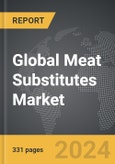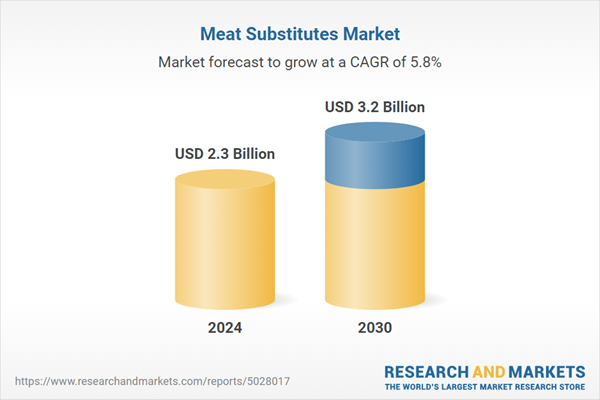The global market for Meat Substitutes was valued at US$2.3 Billion in 2024 and is projected to reach US$3.2 Billion by 2030, growing at a CAGR of 5.8% from 2024 to 2030. This comprehensive report provides an in-depth analysis of market trends, drivers, and forecasts, helping you make informed business decisions. The report includes the most recent global tariff developments and how they impact the Meat Substitutes market.
Segments: Type (Tofu, Tempeh, Seitan, Quorn, Other Types); Source (Soy Protein, Wheat Protein, Pea Protein, Other Sources).
Geographic Regions/Countries: World; United States; Canada; Japan; China; Europe (France; Germany; Italy; United Kingdom; and Rest of Europe); Asia-Pacific; Rest of World.
The analysts continuously track trade developments worldwide, drawing insights from leading global economists and over 200 industry and policy institutions, including think tanks, trade organizations, and national economic advisory bodies. This intelligence is integrated into forecasting models to provide timely, data-driven analysis of emerging risks and opportunities.
Global Meat Substitutes Market - Key Trends & Drivers Summarized
What Are Meat Substitutes and Why Are They Gaining Popularity?
Meat substitutes, also known as meat analogues or plant-based meats, are products designed to mimic the taste, texture, and appearance of animal meat, catering primarily to vegetarians, vegans, and individuals looking to reduce their meat consumption due to health, environmental, or ethical reasons. These substitutes are typically made from ingredients like soy, peas, wheat, and mycoprotein, offering high protein content along with essential nutrients. The increasing awareness of the health risks associated with red and processed meats, such as heart disease and cancer, has significantly contributed to the growing popularity of meat substitutes. Additionally, environmental concerns related to animal farming - including greenhouse gas emissions and land use - further drive individuals towards plant-based diets, positioning meat substitutes as a sustainable and ethical choice that aligns with modern consumer values and lifestyle preferences.How Is Innovation Shaping the Meat Substitute Industry?
Innovation is at the heart of the meat substitute industry, with companies continuously developing new products that better replicate the sensory qualities of meat to appeal to a broader audience, including meat-eaters. Technological advancements in food science and texture engineering have led to the creation of products like Impossible Foods’ and Beyond Meat’s burgers, which sizzle, taste, and bleed like beef, thanks to the use of heme - an iron-containing molecule derived from plants. These products are not only designed to look and cook like meat but also to provide a comparable nutritional profile, which is key to attracting health-conscious consumers. Additionally, the emergence of fermentation technology and 3D food printing offers promising avenues to further enhance the texture and flavor of meat substitutes, making them more palatable to traditional meat consumers and ensuring a better integration into everyday cuisine.What Impact Are Meat Substitutes Having on the Food Industry and Agriculture?
The rise of meat substitutes is significantly impacting the food industry and agriculture, prompting a shift in resource allocation from traditional livestock farming to more sustainable crop production for plant-based proteins. As the demand for meat substitutes grows, there is an increasing need for crops such as soy, peas, and beans, which are primary ingredients in many plant-based products. This shift not only helps reduce the environmental footprint associated with animal agriculture but also opens up new opportunities for farmers and producers to diversify and innovate within their crop production strategies. Furthermore, the food industry sees a transformation in product offerings, with major food companies and restaurants incorporating meat substitutes into their menus to cater to the evolving consumer preferences. This integration challenges traditional food production and supply chain models, necessitating new strategies for sourcing, manufacturing, and distribution.What Are the Primary Drivers Behind the Expanding Market for Meat Substitutes?
The growth in the meat substitutes market is driven by several factors, notably the increasing consumer awareness of the health and environmental impacts of meat consumption. The burgeoning vegan and vegetarian population, alongside flexitarians seeking to reduce meat intake, significantly contributes to the demand. Technological innovations that enhance the taste and texture of plant-based products are making these substitutes more appealing to a broader demographic. Additionally, growing concerns over animal welfare encourage more consumers to turn to meat alternatives as a more ethical choice. Economic factors also play a role; as the cost of producing plant-based products decreases with advancements in agricultural practices and food processing technologies, these products become more accessible to the average consumer. Finally, the influence of social media and celebrity endorsements has heightened awareness and acceptance of meat substitutes, further propelling market growth and diversification into new regions and demographics.Report Scope
The report analyzes the Meat Substitutes market, presented in terms of units. The analysis covers the key segments and geographic regions outlined below.Segments: Type (Tofu, Tempeh, Seitan, Quorn, Other Types); Source (Soy Protein, Wheat Protein, Pea Protein, Other Sources).
Geographic Regions/Countries: World; United States; Canada; Japan; China; Europe (France; Germany; Italy; United Kingdom; and Rest of Europe); Asia-Pacific; Rest of World.
Key Insights:
- Market Growth: Understand the significant growth trajectory of the Tofu segment, which is expected to reach US$1.1 Billion by 2030 with a CAGR of a 6.6%. The Tempeh segment is also set to grow at 6.1% CAGR over the analysis period.
- Regional Analysis: Gain insights into the U.S. market, valued at $620.2 Million in 2024, and China, forecasted to grow at an impressive 5.0% CAGR to reach $497.3 Million by 2030. Discover growth trends in other key regions, including Japan, Canada, Germany, and the Asia-Pacific.
Why You Should Buy This Report:
- Detailed Market Analysis: Access a thorough analysis of the Global Meat Substitutes Market, covering all major geographic regions and market segments.
- Competitive Insights: Get an overview of the competitive landscape, including the market presence of major players across different geographies.
- Future Trends and Drivers: Understand the key trends and drivers shaping the future of the Global Meat Substitutes Market.
- Actionable Insights: Benefit from actionable insights that can help you identify new revenue opportunities and make strategic business decisions.
Key Questions Answered:
- How is the Global Meat Substitutes Market expected to evolve by 2030?
- What are the main drivers and restraints affecting the market?
- Which market segments will grow the most over the forecast period?
- How will market shares for different regions and segments change by 2030?
- Who are the leading players in the market, and what are their prospects?
Report Features:
- Comprehensive Market Data: Independent analysis of annual sales and market forecasts in US$ Million from 2024 to 2030.
- In-Depth Regional Analysis: Detailed insights into key markets, including the U.S., China, Japan, Canada, Europe, Asia-Pacific, Latin America, Middle East, and Africa.
- Company Profiles: Coverage of players such as Amy's Kitchen, Inc., Archer Daniels Midland Company, Beyond Meat, Dow, Inc., DuPont de Nemours, Inc. and more.
- Complimentary Updates: Receive free report updates for one year to keep you informed of the latest market developments.
Some of the 58 companies featured in this Meat Substitutes market report include:
- Amy's Kitchen, Inc.
- Archer Daniels Midland Company
- Beyond Meat
- Dow, Inc.
- DuPont de Nemours, Inc.
- Gardein
- Meatless
- MGP Ingredients, Inc.
- Morningstar Farms L.C
- Quorn Foods
- Sonic Biochem Extraction Pvt., Ltd.
- The Nisshin OilliO Group Ltd.
- VBites Foods Limited
Tariff Impact Analysis: Key Insights for 2025
Global tariff negotiations across 180+ countries are reshaping supply chains, costs, and competitiveness. This report reflects the latest developments as of April 2025 and incorporates forward-looking insights into the market outlook.The analysts continuously track trade developments worldwide, drawing insights from leading global economists and over 200 industry and policy institutions, including think tanks, trade organizations, and national economic advisory bodies. This intelligence is integrated into forecasting models to provide timely, data-driven analysis of emerging risks and opportunities.
What’s Included in This Edition:
- Tariff-adjusted market forecasts by region and segment
- Analysis of cost and supply chain implications by sourcing and trade exposure
- Strategic insights into geographic shifts
Buyers receive a free July 2025 update with:
- Finalized tariff impacts and new trade agreement effects
- Updated projections reflecting global sourcing and cost shifts
- Expanded country-specific coverage across the industry
Table of Contents
I. METHODOLOGYII. EXECUTIVE SUMMARY2. FOCUS ON SELECT PLAYERSIII. MARKET ANALYSISIV. COMPETITION
1. MARKET OVERVIEW
3. MARKET TRENDS & DRIVERS
4. GLOBAL MARKET PERSPECTIVE
UNITED STATES
CANADA
JAPAN
CHINA
EUROPE
FRANCE
GERMANY
ITALY
UNITED KINGDOM
REST OF EUROPE
ASIA-PACIFIC
REST OF WORLD
Companies Mentioned (Partial List)
A selection of companies mentioned in this report includes, but is not limited to:
- Amy's Kitchen, Inc.
- Archer Daniels Midland Company
- Beyond Meat
- Dow, Inc.
- DuPont de Nemours, Inc.
- Gardein
- Meatless
- MGP Ingredients, Inc.
- Morningstar Farms L.C
- Quorn Foods
- Sonic Biochem Extraction Pvt., Ltd.
- The Nisshin OilliO Group Ltd.
- VBites Foods Limited
Table Information
| Report Attribute | Details |
|---|---|
| No. of Pages | 331 |
| Published | April 2025 |
| Forecast Period | 2024 - 2030 |
| Estimated Market Value ( USD | $ 2.3 Billion |
| Forecasted Market Value ( USD | $ 3.2 Billion |
| Compound Annual Growth Rate | 5.8% |
| Regions Covered | Global |









